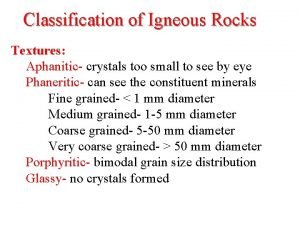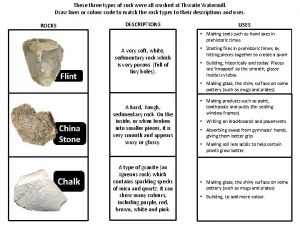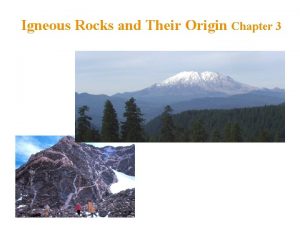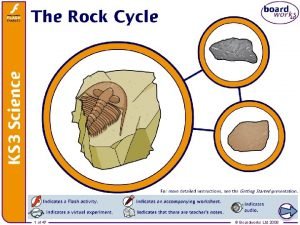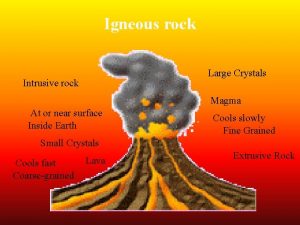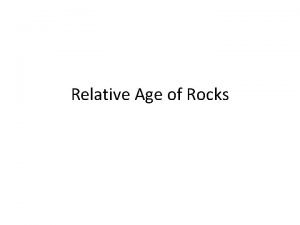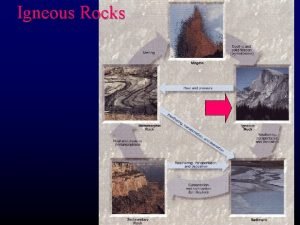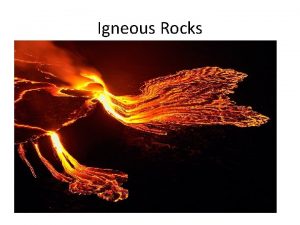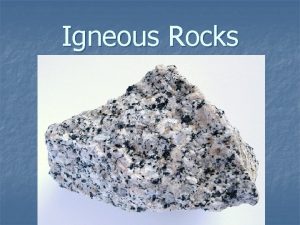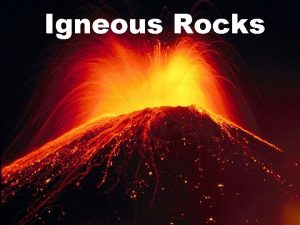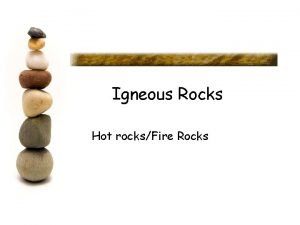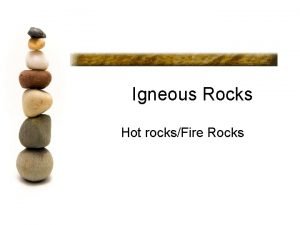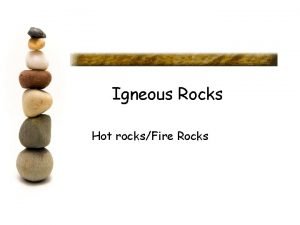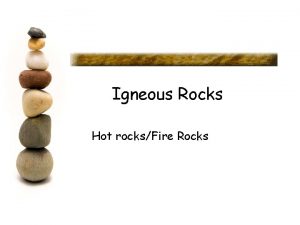TOPOGRAPHY ASSOCIATED WITH MASSIVE IGNEOUS ROCKS 11 Massive













- Slides: 13

TOPOGRAPHY ASSOCIATED WITH MASSIVE IGNEOUS ROCKS 11

• Massive igneous rocks are not stratified. They solidified at depth as a great compact mass and cooling was therefore slow. Because of this slow cooling process, there was sufficient time for large crystals to develop. These large masses can assume a variety of forms, namely, batholiths, laccoliths, lopoliths, dykes and sills as well as tors. 2

INTRUSIVE IGNEOUS ROCKS CONE PIPE SILL LACCOLITHS BATHOLITHS DYKE 9

• Batholiths – The largest of the dome-shaped intrusive forms is a batholiths. It reaches down to such great depths, increasing in size deeper down, that it seems to have no lower limit. Even the exposed part at the Earth’s surface often extends over several thousand square kilometres. The batholiths constituting the Canadian Coast Mountains is approximately 1 700 kilometres long and 180 km wide in places. 2

5

• Laccoliths – The laccoliths is very much smaller than a batholiths. It is also formed by the erosion of magma amongst other strata, e. g. between sedimentary layers of rock. The overlying layers have to be removed before the laccoliths itself is visible. Apart from the pipe along which the magma moved upwards, which is still connected to the original magma source, the laccoliths does not reach down to such great depths and it has a definite floor. 3

• Laccoliths – The laccoliths is very much smaller than a batholiths. It is also formed by the erosion of magma amongst other strata, e. g. between sedimentary layers of rock. The overlying layers have to be removed before the laccoliths itself is visible. Apart from the pipe along which the magma moved upwards, which is still connected to the original magma source, the laccoliths does not reach down to such great depths and it has a definite floor. 3

• Lopoliths – Lopoliths is formed in much the same way as a laccoliths, but the sedimentary strata between which magma has intruded have been unable to bear the weight. The floor has collapsed to form a shallow, saucer-shaped intrusive form. The largest known lopoliths in the world is the Bushveld Igneous Complex. • Sills - A sill is a tabular sheet intrusion that has been intruded between older layers of sedimentary rock, beds of volcanic lava or even along the direction of foliation in metamorphic rock. 4

• Dykes and Sills – Dykes and sills can be the same material from the same source. Dykes find and fill vertical structural weaknesses. If they find a weaker horizontal plane, they fill that too, forming a sill. • Dykes - A dyke is an intrusion into an opening crosscutting fissure, shouldering aside other pre-existing layers or bodies of rock. This implies that a dyke is always younger than the rocks that contain it. 5

GRANITE DOME 8

Granite Domes • Domes form when a batholith or laccolith is uncovered by erosion and a large dome is visible above ground • Exfoliation takes place on the outer surface and round the dome • Exfoliation occur when the outer rock layers peels off due to contraction and expansion due to warm day and cold night temperatures. 11

• Tors - A tor is a large, free-standing residual mass that rises abruptly from the surrounding smooth and gentle slopes of a rounded hill summit or ridge crest. Tors are composed usually of granite or metamorphic rocks. Tors can also be found around any previously erupted volcanoes, though occasionally of other hard rocks such as quartzite and are the result of millions of years of weathering. • Tors form when a batholith of laccolith weathers and erodes along the joints and weather planes in the rock before • The tor is uncovered by erosion and looks like a stack of rocks cut form the same original stone. 6

TORS 10
 Massive igneous rocks
Massive igneous rocks Types of igneous rock
Types of igneous rock Igneous rocks metamorphic rocks and sedimentary rocks
Igneous rocks metamorphic rocks and sedimentary rocks Iugs classification of igneous rocks
Iugs classification of igneous rocks Characteristics of igneous rocks
Characteristics of igneous rocks How igneous rocks are formed
How igneous rocks are formed Igneous rock properties
Igneous rock properties Igneous rock
Igneous rock Concept map for igneous rocks
Concept map for igneous rocks Igneous rocks
Igneous rocks What is reletive age
What is reletive age Igneous rocks
Igneous rocks Textura
Textura Inequigranular texture igneous rocks
Inequigranular texture igneous rocks



